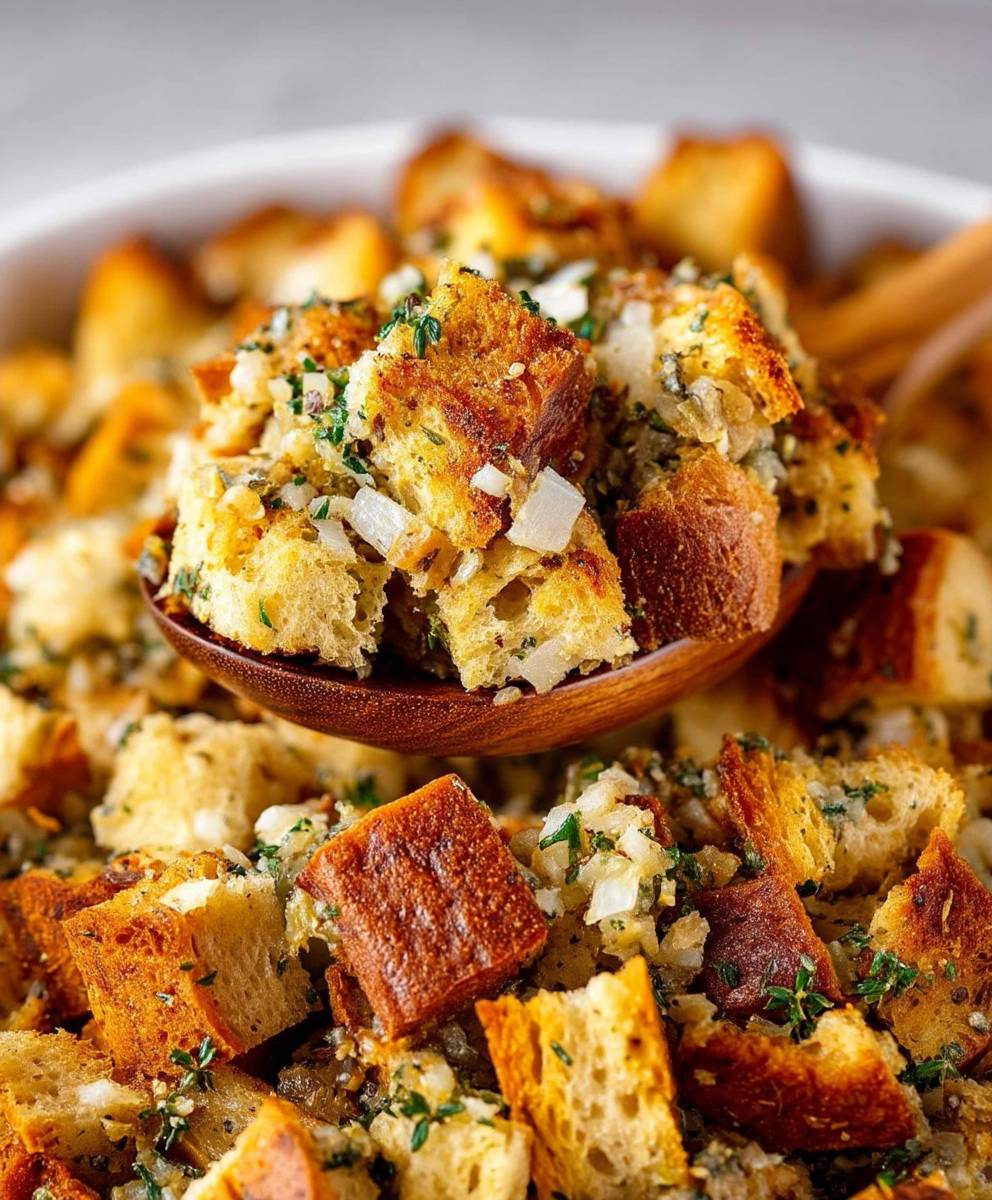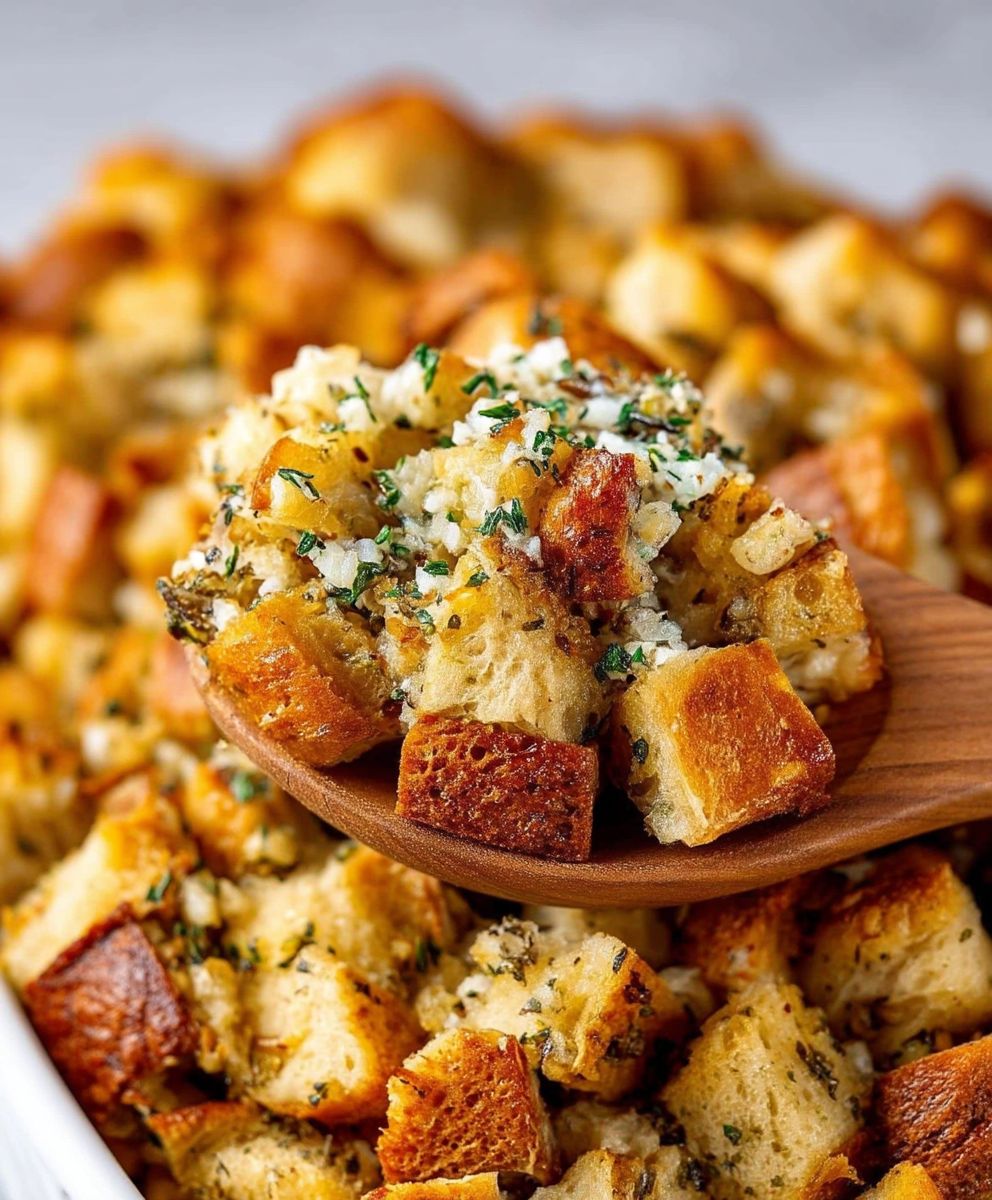Classic Bread Stuffing: Is there anything that screams “holiday feast” quite like it? Imagine the aroma wafting through your home, a comforting blend of herbs, savory broth, and perfectly toasted bread. It’s a dish that evokes memories of family gatherings, crackling fireplaces, and overflowing plates. But beyond the nostalgia, classic bread stuffing is a culinary masterpiece in its own right, a testament to simple ingredients transformed into something truly extraordinary.
While the exact origins are debated, stuffing (or dressing, depending on where you’re from!) has been a part of culinary tradition for centuries. Early versions were often used as a practical way to cook meat, keeping it moist and flavorful during roasting. Over time, it evolved from a simple filler to a star side dish, showcasing regional variations and family secrets passed down through generations.
So, why do we love it so much? It’s the delightful combination of textures the soft, yielding bread contrasted with the crisp edges, the savory herbs mingling with the richness of the broth. It’s also incredibly versatile! You can customize it with your favorite vegetables, meats, or even fruits to create a unique flavor profile. And let’s be honest, it’s just plain delicious! Whether you’re a seasoned chef or a kitchen novice, this recipe is sure to impress. Let’s get started!
Ingredients:
- 1 loaf (about 1 pound) day-old white bread, cut into 1/2-inch cubes
- 1/2 cup (1 stick) unsalted butter
- 1 large yellow onion, chopped
- 2 celery stalks, chopped
- 1 teaspoon dried thyme
- 1 teaspoon dried sage
- 1/2 teaspoon dried marjoram
- 1/4 teaspoon ground black pepper
- 1/4 teaspoon salt, or to taste
- 4 cups chicken broth, low sodium
- 2 large eggs, lightly beaten
- 1/2 cup chopped fresh parsley
Preparing the Bread
Okay, let’s start with the foundation of our stuffing: the bread! Using day-old bread is crucial because it’s drier and will absorb the flavors of the broth and seasonings without becoming mushy. If you only have fresh bread, don’t worry! You can easily dry it out.
- Preheat your oven to 300°F (150°C). This low temperature will gently dry the bread without toasting it too much.
- Spread the bread cubes in a single layer on a large baking sheet. Make sure they’re not overcrowded; you want air to circulate around each cube.
- Bake for about 20-30 minutes, flipping the bread cubes halfway through, until they are dry and lightly toasted. You want them to be crisp but not browned. Keep a close eye on them, as ovens can vary!
- Remove the bread from the oven and let it cool completely. This is important because adding warm bread to the wet ingredients can make the stuffing gummy.
Sautéing the Aromatics
Next up, we’re building flavor! Sautéing the onion and celery in butter is the key to a fragrant and delicious stuffing. This step softens the vegetables and releases their natural sweetness, which will infuse the entire dish.
- Melt the butter in a large skillet or Dutch oven over medium heat. Make sure the skillet is large enough to eventually hold all the bread cubes.
- Add the chopped onion and celery to the melted butter. Stir to coat them well.
- Cook, stirring occasionally, until the onion is translucent and softened, about 8-10 minutes. You don’t want them to brown, just become tender.
- Stir in the dried thyme, sage, marjoram, salt, and pepper. Cook for another minute, stirring constantly, until fragrant. This step blooms the spices, enhancing their flavor.
- Remove the skillet from the heat. We’re ready to move on to the next step!
Combining the Ingredients
Now for the fun part: bringing everything together! This is where the magic happens, and all those individual components start to transform into a cohesive and flavorful stuffing.
- In a very large bowl, combine the dried bread cubes and the sautéed onion and celery mixture. Gently toss everything together to distribute the vegetables and spices evenly throughout the bread.
- In a separate bowl, whisk together the chicken broth and the lightly beaten eggs. The eggs will help bind the stuffing together and give it a slightly richer texture.
- Pour the chicken broth and egg mixture over the bread mixture. Gently toss to combine, making sure all the bread cubes are moistened. Don’t overmix, as this can make the stuffing tough.
- Stir in the chopped fresh parsley. The parsley adds a pop of freshness and color to the stuffing.
- At this point, you can taste the stuffing and adjust the seasoning as needed. Add more salt, pepper, or herbs to your liking. Remember that the flavors will intensify as the stuffing bakes.
Baking the Stuffing
Almost there! Now it’s time to bake our stuffing to golden-brown perfection. You have a couple of options here: you can bake it in a baking dish or stuff it inside a turkey (if you’re making one). I’ll give you instructions for both methods.
Baking in a Baking Dish:
- Preheat your oven to 350°F (175°C).
- Grease a 9×13 inch baking dish with butter or cooking spray. This will prevent the stuffing from sticking to the dish.
- Pour the stuffing mixture into the prepared baking dish. Spread it out evenly.
- Cover the baking dish with aluminum foil. This will help keep the stuffing moist during the first part of baking.
- Bake for 30 minutes, covered.
- Remove the foil and bake for another 15-20 minutes, or until the top is golden brown and the stuffing is heated through. The internal temperature should reach 165°F (74°C).
- Let the stuffing rest for 10 minutes before serving. This allows the flavors to meld together and the stuffing to set up slightly.
Stuffing a Turkey:
Important Note: Stuffing a turkey can increase the cooking time and may pose a food safety risk if not done properly. Make sure the turkey and the stuffing both reach a safe internal temperature.
- Prepare your turkey according to your recipe.
- Loosely stuff the cavity of the turkey with the stuffing mixture. Do not pack it tightly, as this can prevent the turkey from cooking evenly.
- Roast the turkey according to your recipe, adding extra cooking time as needed to ensure that the stuffing reaches an internal temperature of 165°F (74°C). Use a meat thermometer to check the temperature in the center of the stuffing.
- Let the turkey rest for at least 20 minutes before carving. This allows the juices to redistribute and the stuffing to set up slightly.
- Remove the stuffing from the turkey before carving and serving.
Serving Suggestions
Your classic bread stuffing is now ready to be enjoyed! It’s the perfect accompaniment to a Thanksgiving or holiday feast, but it’s also delicious any time of year. Here are a few serving suggestions:
- Serve it alongside roasted turkey, chicken, or ham.
- Top it with gravy for an extra layer of flavor.
- Add it to a leftover turkey sandwich.
- Serve it as a side dish with a simple weeknight meal.
Enjoy your homemade stuffing! I hope this recipe becomes a family favorite.

Conclusion:
So there you have it! This Classic Bread Stuffing recipe is more than just a side dish; it’s a warm hug on a plate, a nostalgic trip back to holiday dinners past, and a guaranteed crowd-pleaser. I truly believe this is a must-try recipe for anyone looking to elevate their holiday spread or simply enjoy a comforting, flavorful meal. Its the kind of dish that makes everyone feel at home, no matter where they are.
What makes this stuffing so special? It’s the perfect balance of textures the crispy edges, the soft, savory interior, and the delightful bursts of flavor from the herbs and vegetables. It’s also incredibly versatile. While I’ve shared my go-to version, feel free to get creative and adapt it to your own tastes.
Serving Suggestions and Variations:
Serving Suggestions: Of course, this stuffing is a natural companion to roasted turkey or chicken. But don’t limit yourself! It’s also fantastic alongside roasted pork loin, baked ham, or even as a vegetarian main course with a side of cranberry sauce and roasted vegetables. For a truly decadent experience, try serving it with a dollop of creamy mashed potatoes and a drizzle of gravy. Leftovers (if there are any!) are amazing in sandwiches, frittatas, or even as a topping for baked potatoes.
Variations: The possibilities are endless! For a sweeter twist, add dried cranberries, chopped apples, or even a touch of maple syrup. If you’re a fan of spice, incorporate some diced jalapeños or a pinch of red pepper flakes. For a richer flavor, use brioche or challah bread instead of sourdough. You can also experiment with different herbs, such as rosemary, thyme, or sage. If you’re looking to add some protein, consider adding cooked sausage, bacon, or even ground beef. For a vegetarian option, try adding mushrooms, walnuts, or chestnuts. And if you’re gluten-free, simply substitute gluten-free bread and ensure all other ingredients are gluten-free as well.
I personally love adding a handful of toasted pecans for a bit of crunch and nutty flavor. Another variation I enjoy is using a combination of different types of bread, such as sourdough, rye, and cornbread, for a more complex flavor profile. Don’t be afraid to experiment and find what works best for you and your family!
I poured my heart into perfecting this Classic Bread Stuffing recipe, and I’m confident that you’ll love it as much as I do. It’s a dish that’s meant to be shared, enjoyed, and savored. It’s a dish that brings people together and creates lasting memories.
So, what are you waiting for? Gather your ingredients, preheat your oven, and get ready to create a truly unforgettable stuffing. I can’t wait to hear about your experience! Please, try this recipe and don’t hesitate to share your photos, tips, and variations in the comments below. I’m always eager to learn from your culinary adventures. Happy cooking, and happy holidays!
I truly believe that this recipe will become a staple in your household, just as it has in mine. It’s a classic for a reason, and I’m so excited for you to experience the joy of making and sharing this delicious dish. Enjoy!
Classic Bread Stuffing: The Ultimate Holiday Recipe
Classic bread stuffing with savory herbs and sautéed vegetables, perfect for holidays.
Ingredients
- 1 loaf (about 1 pound) day-old white bread, cut into 1/2-inch cubes
- 1/2 cup (1 stick) unsalted butter
- 1 large yellow onion, chopped
- 2 celery stalks, chopped
- 1 teaspoon dried thyme
- 1 teaspoon dried sage
- 1/2 teaspoon dried marjoram
- 1/4 teaspoon ground black pepper
- 1/4 teaspoon salt, or to taste
- 4 cups chicken broth, low sodium
- 2 large eggs, lightly beaten
- 1/2 cup chopped fresh parsley
Instructions
- Prepare the Bread: Preheat oven to 300°F (150°C). Spread bread cubes in a single layer on a baking sheet. Bake for 20-30 minutes, flipping halfway, until dry and lightly toasted. Let cool completely.
- Sauté the Aromatics: Melt butter in a large skillet or Dutch oven over medium heat. Add onion and celery; cook, stirring occasionally, until softened, about 8-10 minutes. Stir in thyme, sage, marjoram, salt, and pepper; cook for 1 minute until fragrant. Remove from heat.
- Combine the Ingredients: In a very large bowl, combine dried bread cubes and sautéed onion and celery mixture. In a separate bowl, whisk together chicken broth and eggs. Pour over bread mixture; gently toss to combine. Stir in parsley. Taste and adjust seasoning as needed.
- Bake in a Baking Dish: Preheat oven to 350°F (175°C). Grease a 9×13 inch baking dish. Pour stuffing mixture into the dish and spread evenly. Cover with foil and bake for 30 minutes. Remove foil and bake for another 15-20 minutes, or until golden brown and heated through (internal temperature of 165°F/74°C). Let rest for 10 minutes before serving.
- Stuffing a Turkey: Loosely stuff the cavity of the turkey with the stuffing mixture. Do not pack it tightly. Roast the turkey according to your recipe, adding extra cooking time as needed to ensure that the stuffing reaches an internal temperature of 165°F (74°C). Let the turkey rest for at least 20 minutes before carving. Remove the stuffing from the turkey before carving and serving.
Notes
- Using day-old bread is crucial for the right texture. If using fresh bread, dry it in the oven as instructed.
- Don’t overmix the stuffing after adding the broth, as this can make it tough.
- When stuffing a turkey, ensure both the turkey and stuffing reach a safe internal temperature of 165°F (74°C).
- Adjust seasoning to your liking. Remember that flavors will intensify during baking.

